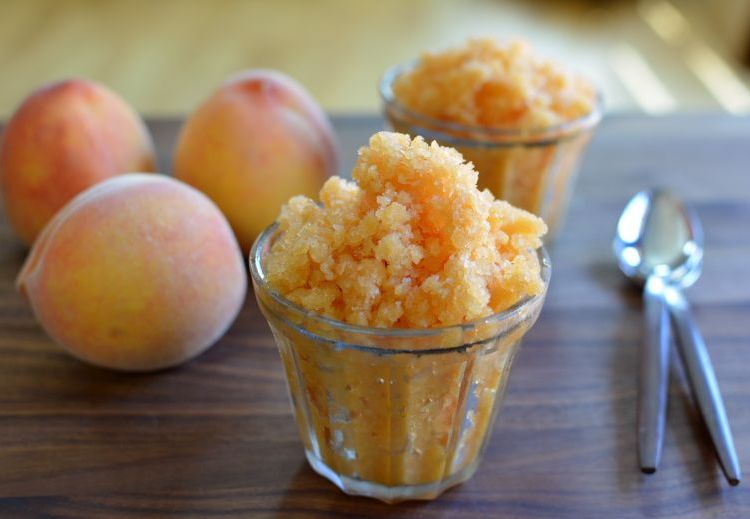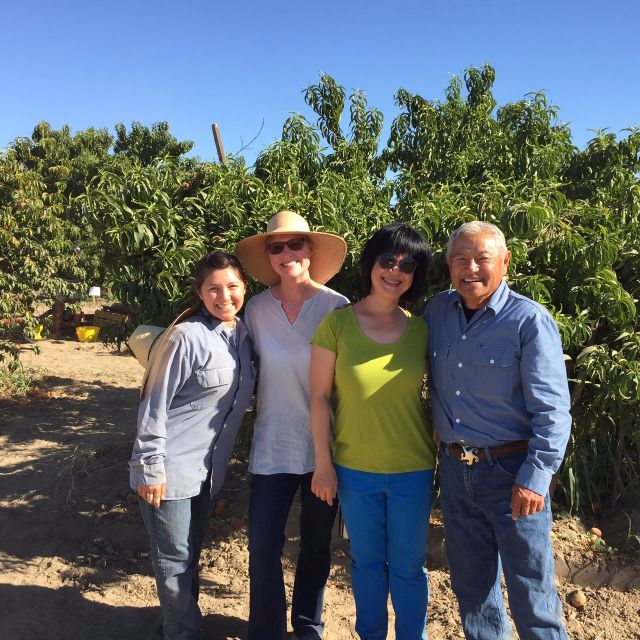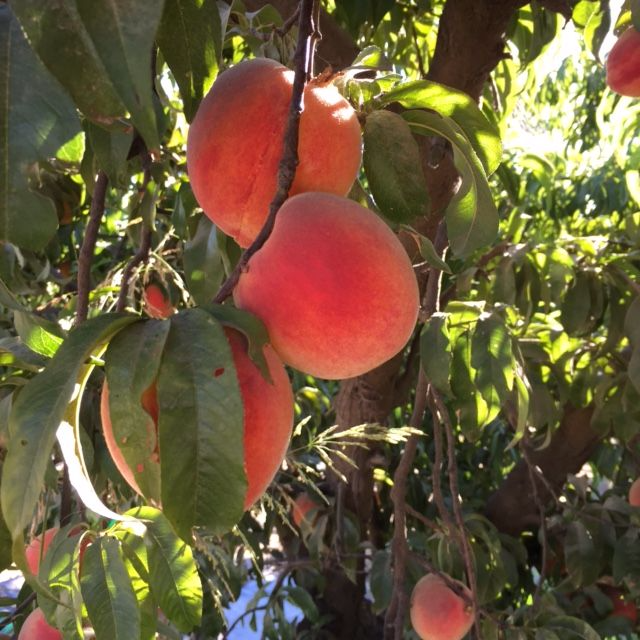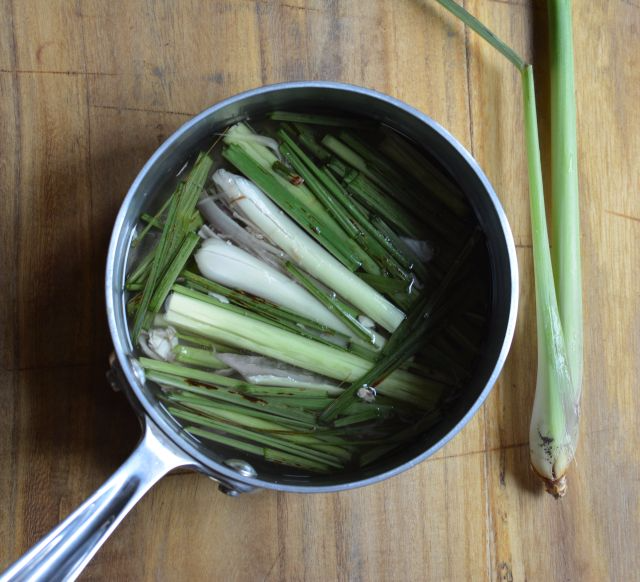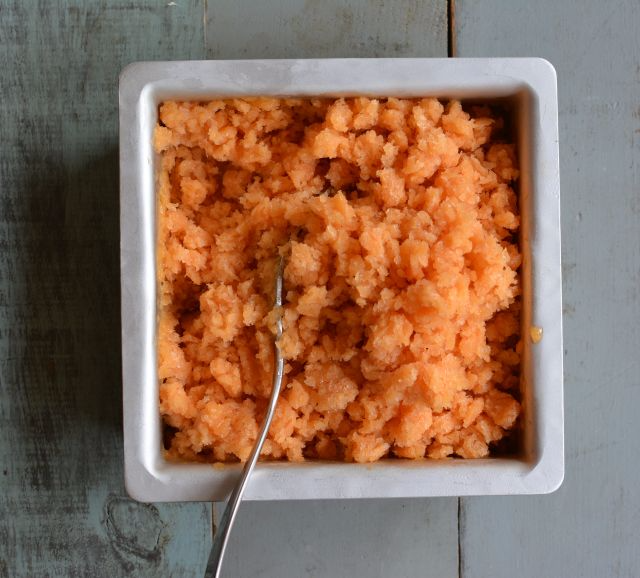I am currently in possession of a very large quantity of the most perfect peaches and nectarines. They are sweet-tangy and so juicy that we often eat them standing over the kitchen sink. The peaches and nectarines were grown by the Masumoto family in Del Rey, located near Fresno, California. Mas Masumoto is renowned for his natural growing methods and champions varieties that are out of fashion. That’s to say, he wants to grow fruit with flavor. They are fragile and inconsistent in size but are full of the essence of summer. They are not fruit that you’ll find at the supermarket because they’re best eaten soon after they’re picked.
Mas, his wife Darcy, and daughter Nikiko work the farm. Romantic as small scale, family farming may sound, it’s not a glamorous life because Fresno is hot, the fruits have minds of their own, and the organic soil is so powdery at times that everything seems coated in a fine layer of dust. What’s glamorous and elegant is the fruit of the labors. Masumoto peaches and nectarines are legendary, prized by high-end restaurants and chefs, as well as home cooks who appreciate good fruit.
The Masumotos have an annual adopt-a-tree program and my friend Jourdan organized a group of us to chip in for Elberta peach and Le Grand nectarine trees. Last week, we harvested our fruit along with about 100 other people who’d gained spots in the Masumoto’s program, which required an application process(!). Each team gets its own trees.
Our "Peach Pit" picking team consisted of me, my husband Rory, Sunset magazine editor Margo True, and Cory, surgeon from Los Angeles. Marta and Arin drove down from San Francisco mid-morning to help pick and ferry our harvest back to share with other shareholders. It was group effort filled with jokes and catching up.
The Peach Pit was among the last teams to leave the farm. In that midday heat and quiet, we heard the gentle thud of ripe peaches and nectarines falling from their trees. The fruit was that ripe.
Before we arrived on Saturday, I studied up on peaches via the Masumoto family's fabulous cookbook, The Perfect Peach. It’s filled with growing tips, well-written recipes, and engaging stories. There are discussions of the cultures and histories from their part of the California Central Valley. If you love peaches, The Perfect Peach is perfect for you. This year, Mas and Nikiko co-wrote Changing Season, a work about small family farms challenges, passing the torch from generation to generation, and how to become a good farmer who may make a decent living.
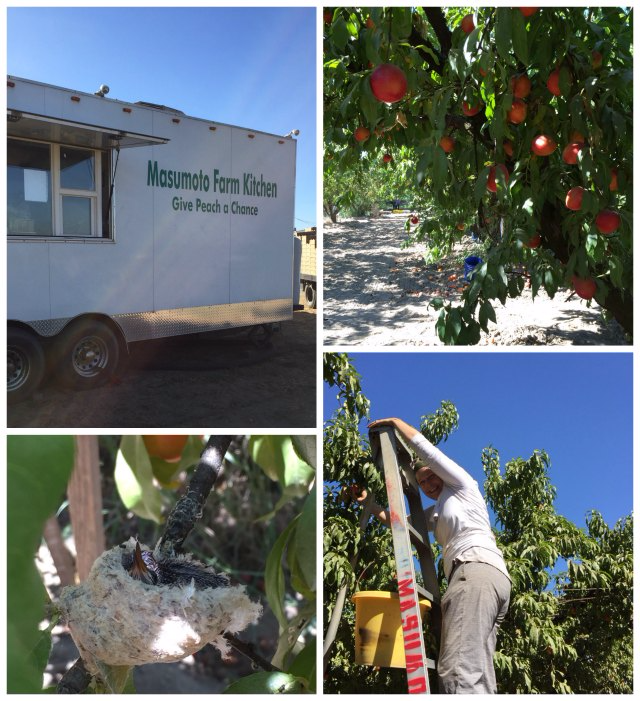
Indeed, Masumoto fruit is much more than just the fruit itself. But what glorious fruit it is! Rory and I have been eating as many peaches and nectarines as we can but we picked a lot last weekend. In an attempt to arrest its freshness, I’ve frozen peeled peach halves, chopped up nectarines, and pureed over-ripe imperfect ‘hospital’ fruit (we rescued them from the ground around our trees). Freezing these fruits for later use was my way of stretching the summer bounty way into winter when the weather will be dreary and I’ll be looking for sunshine.
I’ve also cooked with some of the fruit. I’ve made the small-batch jam from The Perfect Peach and it’s delicious as well as simple. At the farm during picking orientation, Nikiko suggested adding tender peach leaves to jams for a light almond flavor. Margo and I picked and chewed on a number of leaves to ascertain that unique flavor. I took Nikiko’s suggestion and it worked; so did freezing quart-size bags of chopped/pureed fruit for future batches. (Note that adding the seeds (noyaux in French) inside the pit adds a bitter almond flavor as well; bang on each pit with hammer or meat mallet. I did that with both the peaches and nectarines that we harvested; you can do the same with other stone fruit. There’s a tiny bit of cyanide in each seed but it’s not enough to harm you.)
This recipe is another beautiful winner. It speaks to the terroir that Nikiko discusses in the book. Fresno’s farming community includes a large group of Southeast Asian farmers. Years ago, I got first-hand knowledge of the community when I researched and wrote a story on a Hmong farming faming in Fresno for Saveur magazine. Much of the Asian produced sold in California is grown my talented and curious Hmong-Lao farmers. I’ve been in their fields, shopped at their markets and eaten at their restaurants – all in Fresno!
So Nikiko was likely inspired by Southeast Asian farmers to pair her peaches with lemongrass. She categorized this recipe as a granita but also made it relatable to a broader audience by describing it simply as a “fancy word for an icy frozen dessert.” She went further to liken it to Mexican raspados shaved ice. As you can imagine, Fresno has a huge Latino population.
The Matsumotos are smart people who are on a mission to connect the dots between nature and humanity. They’re observing the people around them as well as the nature that surrounds them. They appreciate and notice minute changes –- for example, the difference between a ripe peach and a gushy one. Small fruit have a concentrated flavor, Mas explained to me and Rory. The larger ones have flavor that travels throughout the fruit as you chew on it.
“What makes the tree sizes different?” I asked Mas.
“I don't know. When you figure that out, tell me,” he replied with characteristic mirth.
Find the best fruit for this granita. You may use all peaches or nectarines, or even combine them. I employed a big lemongrass stalk from my garden and included the blades for extra oomph.
Recipe
Peach-Lemongrass Granita
Serves 4 to 6
Ingredients
- 2 medium, or 1 fat lemongrass stalk
- ½ cup (3.5 oz) sugar
- 1 cup water
- 4 gushy-ripe, large peaches, peeled, pitted and quartered
- ¼ cup freshly squeezed lemon juice
Method
- Cut the lemongrass into index-finger lengths. Whack the stalk pieces with a meat mallet to crush then transfer to a small saucepan.
- Add the water and sugar. Set over medium-low heat, stirring occasionally, until the sugar dissolves. Slide to a cool burner and let steep for 30 minutes, or until completely cool. Remove large pieces of lemongrass, then strain the syrup through a fine mesh strainer into a bowl. Keep the strainer atop the bowl to use in the next step.
- Use a blender or food processor to whirl the peaches and lemon juice into a smooth, thick mixture. Pass through the fine mesh strainer still sitting atop the bowl; discard any lingering bits. Stir the mixture together and let cool completely before pouring into a casserole or lasagna pan. Use something about 2-inches (5 cm) deep because the mixture will fluff up and occupy lots more space.
- Freeze for 2 hours, or until the sides and bottom have solidified. Use a fork to break and loosen the mixture to create a wet, slushielike texture. Freeze for 6 to 8 hours, until frozen solid.
- Remove from the freezer and use a fork to further scrape and fluff the mixture to arrive at icy flakes. If the mixture hardened too much, let sit in the fridge for 1 to 2 hours or at room temperature for 30 minutes or so to soften enough to scrape. There should be some resistance but you shouldn't struggle. Refreeze if the mixture warmed up and began melting while you scraped. If you’re not ready to serve after fluffing, refreeze and re-fluff, as needed. It’s just liquid. When done, portion into serving dishes or small cups and eat with spoons.
Adapted from The Perfect Peach (Ten Speed Press, 2013)
What's your favorite way to enjoy summer's bounty of stone fruit?
More ways to celebrate stone fruit:













